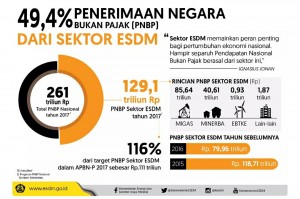State Revenues from Oil and Gas Sector Bigger than Energy Subsidy in 2017: Report
 Energy and mineral resources sector is considered to play a significant role in safeguarding Indonesias financial stability in 2017.
Energy and mineral resources sector is considered to play a significant role in safeguarding Indonesias financial stability in 2017.
The amount of energy subsidy last year slightly exceeded the target of the 2017 Revised State Budget (APBN-P); yet, the contribution of energy and mineral resources sector for state revenues reports a much higher growth.
Based on performance report in early 2017 (unaudited), the amount of energy subsidy was recorded at Rp97.6 trillion, equal to 108,7% from the 2017 Revised State Budget at Rp89.9 trillion.
This achievement is due to the Governments efforts to bring justice for the people by providing additional electricity subsidy for 2.44 million customers categorized as poor families with the capacity of 900 VA in July 2017; so the number increased into 6.54 million customers. The move was also based on the Governments serious efforts to bring justice and equality in electricity access for the whole Indonesian People. The policy was made through a joint agreement between the Government and Commission VII of the House of Representatives (DPR) overseeing energy affairs in July 2017.
The amount of energy subsidy distributed is certainly not significant compared to the contribution of revenues from the energy and mineral resources sector.
In 2017, state revenues from the energy and mineral resources sector significantly increased into Rp178.1 trillion, consisting of Non-Tax State Revenues (PNBP) amounting to Rp129.1 trillion and income taxes (PPh) from oil and gas sector amounting to Rp49 trillion. The Non-Tax State Revenues of energy and mineral resources sector amounting to Rp129.1 trillion contributed almost 50 percent from the PNBP national target as stated in the 2017 Revised State Budget. The amount is derived from oil and natural gas sub-sectors amounting to Rp85.64 trillion, mineral and coal reaching Rp40.61 trillion, new and renewable energy reaching Rp0.91 trillion and others reaching Rp1.89 trillion.
Overall, the amount of Non-Tax State Revenues from the energy and mineral resources sector in 2017 grew by 61.6 percent from that in 2016 at Rp79.9 trillion.
If calculate from 2017 state finance especially in energy and mineral resources sector, that is by comparing Non-Tax State Revenue from energy and mineral resources and energy subsidy, there is a surplus of around Rp31.5 trillion. Even if the comparison is between the total of Non-Tax State Revenues from the energy and mineral resources sector and income taxes from oil and gas sector with energy subsidy, the surplus is bigger, amounting to Rp80,5 trillion.
In response to this achievement, Minister of Energy and Mineral Resources Ignasius Jonan stressed that the energy and mineral resources sector plays an important role in promoting national economic growth.
The energy and mineral resources sector plays an important role for the national economic growth, Jonan said recently as quoted from the official website of the Ministry of Energy and Mineral Resources www.esdm.go.id. (Tim Komunikasi ESDM/EN) (EP/YM/Naster)








